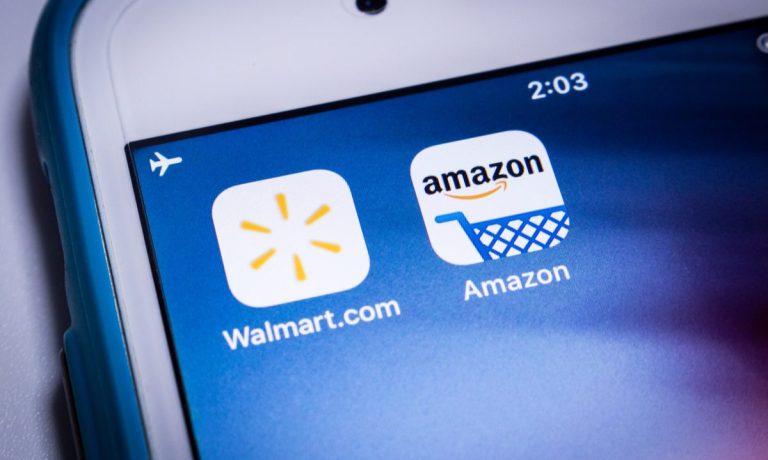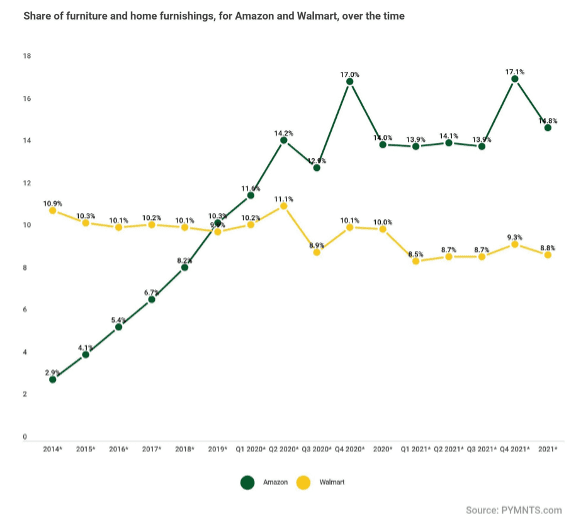
“The supreme art of war is to subdue the enemy without fighting,” the Chinese general and famed military strategist Sun Tzu proclaimed almost 600 years ago, and yet, this oft-quoted quip somehow remains relevant today in a 21st century food fight among the top two retailers.
As much as the ongoing saga of Amazon swiping Walmart’s retail market share in category after category is not new, the fact that the battle has now shifted to the final frontier — groceries — is significant.
If five prior examples of category leadership change over the past decade were not precedent enough, the sheer fact that this last, lone, lagging segment stands out like a sore thumb for Amazon would suggest that it is on the top of the eCommerce giant’s to-do list.
Like it did with electronics and appliances, furniture and home furnishing, clothing and apparel, and more, Amazon steadily worked to erode Walmart’s lead before ultimately pulling ahead, a crossover that is dramatically illustrated in a series of “X charts” such as the one below.

While PYMNTS first-quarter research and data showed Walmart still holding almost a 10x advantage in domestic food and beverage sales with its 17.7% to 1.9% market share lead, reversing that category — which also happens to be Walmart’s single-largest source of revenue and accounted for roughly 56% of its annual total in 2021 — will not be easy or fast.
In fact, the latest PYMNTS data released this week shows the spread tightened ever so slightly — but tightened nonetheless.
Clearly Amazon and Walmart are aware of the situation and are equally determined to respectively change the status quo or maintain it via a series of different adjustments and initiatives.
It’s a shift that PYMNTS’ Karen Webster collectively characterized this week as Amazon fighting for a seat at the dinner table, not only through its expanding grocery business but also via its newer endeavors into prepared foods and restaurants.
“Amazon — with Whole Foods, Amazon Fresh, high-spending Prime Members, embedded one-click payments, last-mile logistics capabilities and a fast-growing prepared foods business that uses its own kitchens — is hiding in plain sight, capable of disrupting how and where consumers find, buy, pay for, and eat their food,” Webster’s latest industry insight pointed out.
And just like the aforementioned X-charts and leadership crossovers of yore, the Seattle-based retailer’s playbook for food is apt to follow the same path in which Amazon leverages its platform assets to gain a foothold, only this this time “it could trigger the reinvention of the grocery and restaurant sectors when it does.”
WWWD — What Will Walmart Do?
Obviously, the stakes are high and the chips are down, and as much as Walmart is comfortably in the lead, they’re likely not relaxing in Bentonville. In fact, by some measures, the pressure is greater on Walmart as the retailer’s every move in this key category is closely scrutinized, the latest of which involves the bundling, or leveraging, of its own Walmart+ platform with its new In-home/In-Fridge delivery service.
“Our members want options and a shopping experience that is easy to navigate and accommodates their individual needs, while saving them time and money — this is true now more than ever,” Chris Cracchiolo, SVP and GM of Walmart+ said in a statement this week, extolling the new benefit as well as the retailer’s plans to expand it to 30 million households before the end of the year.
No sooner had Walmart made its move in the rolling food fight when Amazon countered with a year of free GrubHub service for its 200+ million Prime subscribers. While fee-free restaurant food delivery is not a direct threat to Walmart’s — or any other grocery store’s — business, it could sway consumer decision making and spending elsewhere at a time when eating at home has seen solid gains in the face of record increases in food prices.
While this battle is likely to be protracted and painful for the two combatants, it will also likely bring a bevy of benefits to consumers in the form of new perks and promos aimed at changing habits and swiping customers.